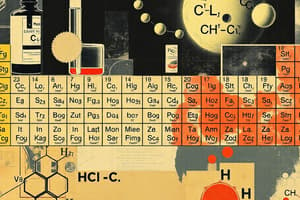Podcast
Questions and Answers
Where are metals located on the periodic table?
Where are metals located on the periodic table?
Metals are located in the middle of the table, to the left of the stair-step line.
Where are metalloids located on the periodic table?
Where are metalloids located on the periodic table?
Metalloids are located to the right of the stair-step line and to the left of the nonmetals.
Where are nonmetals located on the periodic table?
Where are nonmetals located on the periodic table?
Nonmetals are located on the far right of the table, after the zig-zag line.
What are three characteristics of metals?
What are three characteristics of metals?
What are three characteristics of nonmetals?
What are three characteristics of nonmetals?
Who developed the first periodic table and how was it arranged?
Who developed the first periodic table and how was it arranged?
Who developed the modern periodic table and how was it arranged?
Who developed the modern periodic table and how was it arranged?
Which family on the periodic table is known as the noble gases?
Which family on the periodic table is known as the noble gases?
Why are noble gases considered non-reactive elements?
Why are noble gases considered non-reactive elements?
Which element has the chemical symbol Au?
Which element has the chemical symbol Au?
Which element has no neutrons?
Which element has no neutrons?
Which element is a transition element and a liquid?
Which element is a transition element and a liquid?
Which halogen is a liquid?
Which halogen is a liquid?
What are the characteristics of alkali metals?
What are the characteristics of alkali metals?
What are the characteristics of alkaline earth metals?
What are the characteristics of alkaline earth metals?
What are the characteristics of the Boron group?
What are the characteristics of the Boron group?
What are the characteristics of the Carbon group?
What are the characteristics of the Carbon group?
What are the characteristics of the Nitrogen group?
What are the characteristics of the Nitrogen group?
What are the characteristics of the Oxygen group?
What are the characteristics of the Oxygen group?
What are the characteristics of halogens?
What are the characteristics of halogens?
What are the characteristics of noble gases?
What are the characteristics of noble gases?
Flashcards are hidden until you start studying
Study Notes
Locations of Elements on the Periodic Table
- Metals occupy the middle section and are positioned to the left of the stair-step line.
- Metalloids are found to the right of the stair-step line and to the left of nonmetals.
- Nonmetals are located on the far right side of the table, past the zig-zag line.
Characteristics of Metals
- Ductile and malleable, allowing them to be drawn into wires or hammered into sheets.
- Excellent conductors of heat and electricity.
- Generally appear shiny in appearance.
Characteristics of Nonmetals
- Lackluster or dull in appearance (not shiny).
- Poor conductors of heat and electricity.
- Not ductile or malleable.
Development of the Periodic Table
- The first periodic table was created by Dmitri Mendeleev, organized by increasing atomic mass.
- The modern periodic table was developed by Henry G.J. Moseley, based on increasing atomic number.
Families of Elements
- Noble Gases (Group 18): Known for their non-reactivity due to having 8 valence electrons.
- Alkali Metals (Group 1): Extremely reactive with one valence electron, typically not found in nature.
- Alkaline Earth Metals (Group 2): Very reactive with two valence electrons, less so than alkali metals.
- Transition Metals (Groups 3-12): Includes metals with variable valence electrons.
- Boron Group (Group 13): Contains 3 valence electrons and is somewhat reactive.
- Carbon Group (Group 14): 4 valence electrons, includes metals, metalloids, and non-metal carbon.
- Nitrogen Group (Group 15): Holds 5 valence electrons with varying reactivity; tends to gain 3 electrons.
- Oxygen Group (Group 16): 6 valence electrons and reactive, tends to gain 2 electrons.
- Halogens (Group 17): Contains 7 valence electrons, extremely reactive, and typically never found uncombined in nature.
Significant Elements and Their Properties
- Gold's chemical symbol is Au.
- Hydrogen is the only element that has no neutrons.
- Mercury (Hg) is a transition element and is liquid at room temperature.
- Bromine (Br) is the only halogen that is a liquid.
Valence Electrons and Reactivity
- Alkali Metals: 1 valence electron, very reactive and soft with a shiny silver color.
- Alkaline Earth Metals: 2 valence electrons, reactive but less so than Group 1, also silver in color.
- Boron Group: 3 valence electrons, somewhat reactive.
- Carbon Group: 4 valence electrons, can either give away or take electrons, includes various types of elements.
- Nitrogen Group: 5 valence electrons, reactivity is variable.
- Oxygen Group: 6 valence electrons, reactive.
- Halogens: 7 valence electrons, seek to gain one electron to complete their shell.
- Noble Gases: 8 valence electrons, non-reactive and characterized as colorless and odorless gases at room temperature.
Studying That Suits You
Use AI to generate personalized quizzes and flashcards to suit your learning preferences.




